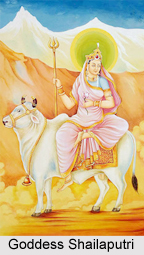 Goddess Shailaputri is the first form of Goddess Durga among the Nava Durga. She is worshipped on the first day of Navaratri. The goddess is also known by the name Sati, Parvati, Bhavani and Hemavati. Goddess Durga took birth in the house of the Himalaya Mountains. It is for this reason that she is known as Shailaputri meaning the daughter of the mountain. The word `shila` means rock and the `putri` means daughter.
Goddess Shailaputri is the first form of Goddess Durga among the Nava Durga. She is worshipped on the first day of Navaratri. The goddess is also known by the name Sati, Parvati, Bhavani and Hemavati. Goddess Durga took birth in the house of the Himalaya Mountains. It is for this reason that she is known as Shailaputri meaning the daughter of the mountain. The word `shila` means rock and the `putri` means daughter.
Legend of Goddess Shailaputri
According to legend Goddess Shailaputri in her previous birth was born as the daughter of Daksh Prajapati. Her name was `Sati` and she was married to Lord Shiva. Once her father, Daksha organised a big yagna and invited all the gods. He however, did not invite Lord Shiva. Sati felt humiliated at the insult of her husband and reached there. There Daksha insulted Shiva and Sati out of rage burnt herself in the yogic fire. In her next birth she was born as the daughter of the Himalayas and was named as Parvati. She was married to Lord Shiva and was known as Shailaputri. She is the first goddess to be worshipped among the Nava Durga. She is also known by the name Hemavati. It is said that in this form she had defeated all the main gods.
Goddess Shailaputri is regarded as the Devi of the root chakra. On awakening she begins her journey upward. She sits on Nandi and starts her journey from the Mooladhara Chakra. Thus, during the Navaratri pooja the worshipper keeps his mind focussed on Mooladhara. The root chakra or the Mooladhara Chakra is considered as the chief chakra in yogic form of meditation. It is regarded as the beginning point of spiritual discipline. During yogic meditation Shailaputri as the Mooladhara Shakti needs to be accomplished with the Self.
Goddess Shailaputri whose abode is the Mooladhara Chakra is thus, regarded as the essence of the earthly existence. The heavenly spirit lies dormant in every human being and hence it needs to be realised.
Attributes of Goddess Shailaputri
Goddess Shailaputri is regarded as the supreme from of Mother Nature. She is known as the holy consort of Lord Shiva as well as the mother of Lord Ganesha and Lord Kartikeya. The goddess has a half moon on her forehead during the Navaratri festival. She is seen riding her mount Nandi, a bull. Goddess Shailaputri holds a trident in her right hand and lotus flower in her left hand. The following mantra is chanted while praying to the goddess.
Vande Vanchitlabhaya Chandradhakritshekhram |
Vrisharudh Shooldharan Shailputri Yashaswineem ||




















